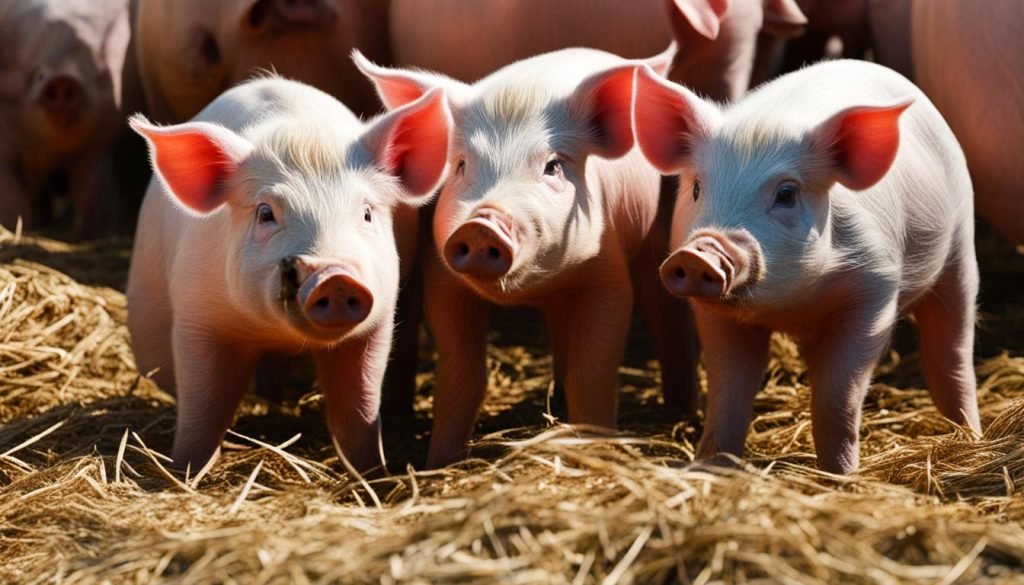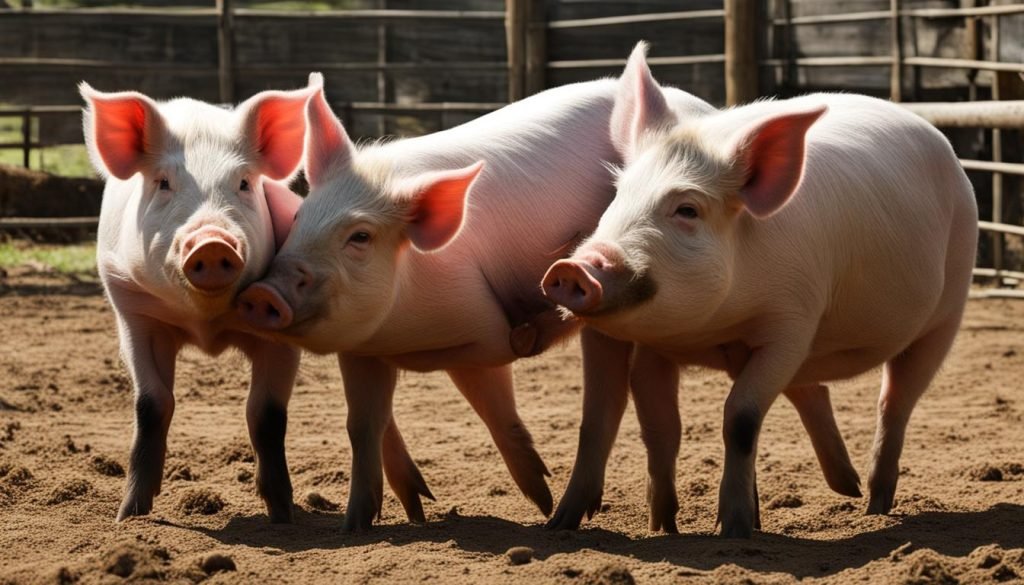How Do Pigs Mate?
Have you ever wondered how pigs mate? The process of pig mating and reproduction can be quite intricate and fascinating. Pig mating behavior and the overall process of pig reproduction involve several stages that are essential for the successful breeding and birth of piglets. In this section, we will explore the details of pig mating behavior and the pig reproductive process.
Key Takeaways
- Pig mating behavior and the process of pig reproduction are essential for the successful breeding and birth of piglets.
- The pig reproductive system involves several stages, including ovulation, fertilization, and gestation.
- Pig breeders optimize pig breeding practices to maximize successful mating and improve overall pig populations.
- The average length of a pig’s gestation period is around 114 days.
- Pig mating habits can vary depending on the species, and courtship rituals and social dynamics can be fascinating to observe.
How Do Pigs Mate: The Pig Mating Process Explained

Understanding the pig mating process is crucial for farmers and breeders who want to optimize pig breeding practices. The pig reproductive cycle, which includes the stages of oestrus, mating, and gestation, lasts an average of 114 days.
Differences in pig mating behavior can be observed between different pig species and even between individual pigs. However, some general patterns can be identified in the mating process.
The Pig Reproductive System
The pig reproductive system is made up of both internal and external reproductive organs. The external organs include the vulva, clitoris, and urethral opening. The internal organs consist of the ovaries, oviducts, uterus, and cervix.
The ovaries are responsible for producing and releasing eggs, while the oviducts transport the eggs down to the uterus. The uterus is where fertilization and implantation of the embryo occur. The cervix acts as a barrier, protecting the uterus from external contamination and regulating the flow of sperm from the vagina into the uterus.
The Pig Mating Process
The pig mating process begins when a female pig enters her oestrus phase, also known as “heat.” During this phase, female pigs become more restless and vocal, and their vulva swells. Male pigs are attracted to the pheromones released by the female during heat. They use their sense of smell to locate a receptive female pig.
Once the male finds the female, he will mount her from behind and attempt to mate. It’s essential to ensure that both pigs are healthy and in good physical condition to maximize the chances of a successful mating.
After mating, the fertilized eggs move down the oviducts and embed themselves in the lining of the uterus. If successful, pregnancy begins, and the gestation process begins.
The Pig Reproductive Cycle
As mentioned earlier, the pig reproductive cycle consists of three stages: oestrus, mating, and gestation. During oestrus, the female pig is in heat and ready to mate. Mating occurs during this phase, and if successful, pregnancy begins. The gestation period lasts 114 days, and during this time, the pig’s body undergoes various changes to support the developing fetuses.
It’s essential to keep the pigs healthy and well-fed throughout the reproductive cycle to ensure successful mating, healthy pregnancies, and births. Proper nutrition, environmental conditions, and veterinary care are crucial in achieving optimal pig breeding outcomes.
Understanding Pig Breeding and Fertility

When it comes to pig reproduction and increasing desirable traits in pig populations, pig breeding plays a vital role. Pig breeding refers to the process of selecting specific pigs to mate to produce offspring with desirable characteristics, such as high meat quality or increased disease resistance.
The success of pig breeding relies heavily on pig fertility, which refers to a pig’s ability to produce viable offspring. Factors such as genetics, nutrition, and environment can all influence pig fertility. To optimize pig breeding practices, breeders must carefully consider these factors and take steps to ensure the highest possible success rate.
Genetics: The genetics of a pig play a significant role in its fertility. To increase fertility rates, breeders often select pigs with desirable genetic traits that are linked to fertility, such as larger litter sizes or increased sperm count. By mating these genetically superior pigs, breeders can increase the likelihood of producing offspring with high fertility rates.
Nutrition: Proper nutrition is critical for pig fertility. A well-balanced diet that provides all necessary nutrients, including vitamins, minerals, and protein, can help ensure optimal reproductive health and function. Conversely, inadequate nutrition can lead to decreased fertility rates and even reproductive failure.
Environment: The environment in which pigs are raised can also impact fertility. Factors such as temperature, humidity, and the presence of pathogens or toxins can all affect reproductive health. Providing a clean, well-ventilated environment and minimizing exposure to stressors can help maintain optimal fertility rates.
Overall, understanding pig breeding and fertility is crucial for anyone involved in pig farming or the pork industry. By carefully managing and optimizing these factors, breeders can help ensure the success and sustainability of pig populations.
The Pig Gestation Period
After a successful mating between a male and female pig, the female enters a period of pregnancy known as the pig gestation period. This is the time between fertilization and the birth of piglets.
The average length of the pig gestation period is approximately 114 days or 3 months, 3 weeks, and 3 days. However, this can vary slightly depending on the breed of the pig and other external factors such as temperature and diet.
During the first month of gestation, the fertilized eggs travel down the female pig’s fallopian tubes and implant themselves into the lining of the uterus. Over the next few months, the piglets develop and grow inside the uterus.
As the gestation period progresses, the pig’s body undergoes numerous changes to support the developing fetuses. The uterus expands to accommodate the growing piglets, and the pig’s appetite increases to provide the necessary nutrients for fetal development.
At the end of the gestation period, the piglets are born through the process of farrowing. This usually occurs within a window of 12-24 hours and can result in the birth of large litters of up to 14 piglets.
It is important to note that the pig gestation period plays a crucial role in pig farming and breeding. Understanding the length of the gestation period is crucial for breeders to plan and manage their operations effectively.
Interesting Pig Mating Habits
While most pigs engage in relatively standard mating behavior, there are some fascinating variations to be found in different pig species. Here are a few of the most interesting pig mating habits:
1. Synchronized Heat Cycles
Female pigs in some species, such as the wild boar, exhibit synchronized heat cycles. This means that all the sows in a particular area go into heat at the same time, which allows for large groups of pigs to mate and breed at once. This behavior is thought to have evolved as a survival mechanism, as it increases the likelihood of successful breeding and maximizes the number of piglets born in a given year.
2. Courtship Rituals
In some pig breeds, males engage in elaborate courtship rituals to attract females. These rituals can involve vocalizations, displays of physical prowess, and even gifts of food or other objects. For example, male warthogs will often present females with sticks or small branches as part of their courtship displays.
3. Social Dynamics
Pigs are highly social animals, and their mating habits often reflect this fact. In some species, such as the domestic pig, males will engage in complex social interactions with each other to establish dominance and win the right to mate with females. This can involve displays of aggression, such as charging and butting heads, as well as more subtle forms of competition, such as social grooming and vocalizations.
4. Multiple Mating Partners
In many cases, female pigs will mate with multiple males throughout a single estrus cycle. This behavior is thought to have evolved as a way for females to increase the genetic diversity of their offspring and ensure the survival of their offspring in different environmental conditions. For example, if one male’s genes are better suited to a dry environment, while another male’s genes are better suited to a wet environment, mating with both males can increase the chances of producing offspring that can thrive in either environment.
5. Spontaneous Abortion
In some cases, female pigs will spontaneously abort their fetuses shortly after mating. This behavior is thought to be a way for the sow to adjust the size of her litter based on environmental conditions and available resources. For example, if food is scarce, the sow may abort some of her fetuses in order to ensure the survival of the remaining piglets.
These are just a few examples of the fascinating and varied world of pig mating behavior. Understanding these behaviors can help us better appreciate the complexity and diversity of these remarkable animals.







